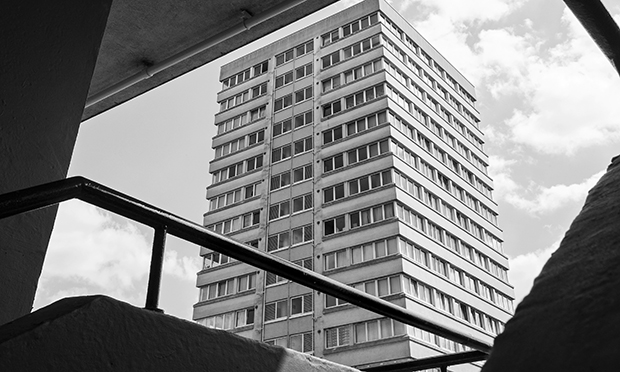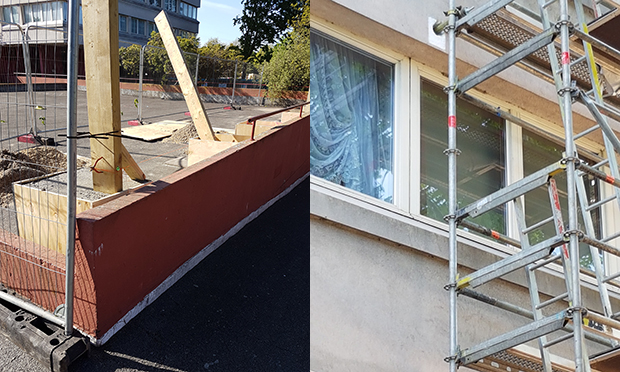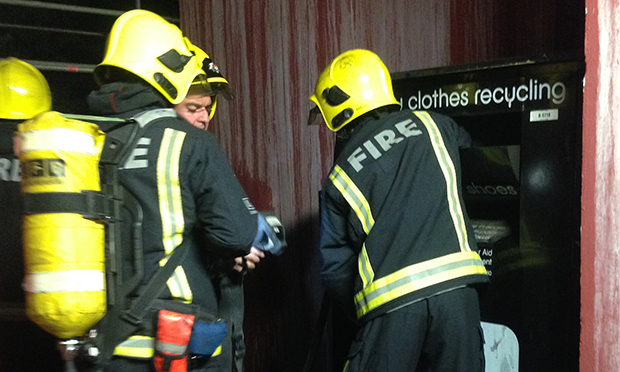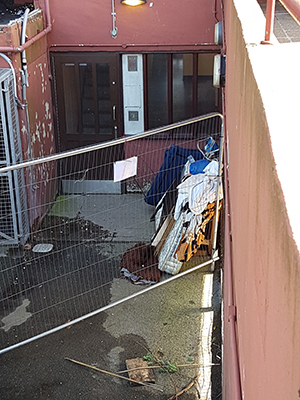Hackney Council stands by cladding contractor following safety complaints

Lincoln Court: cladding failed safety standards. Photograph: Simon Phipps
Hackney Council has backed the contractor replacing cladding on three tower blocks in Woodberry Down after a number of allegations from residents about safety failings during the work.
Building firm Wates was hired by the Town Hall to change the cladding at Lincoln Court after an investigation in the wake of last June’s Grenfell tragedy found it was not up to modern safety standards.
But a number of residents have raised concerns with both the council and Wates about safety issues during the work.
Garry Saunders, a recently retired health and safety manager for Hackney Council who lives at the block with his partner, has sent several emails to the Town Hall, including a formal complaint to Mayor Philip Glanville.
In them, he claims polystyrene has been left temporarily exposed by gaps in the flammable insulation, combustible waste next to the buildings has not been removed and a fire exit has been blocked with no alternative arrangements provided to residents.
Saunders and another resident have also complained about building materials, including an electricity cable, being dumped on a children’s play area at the blocks without sufficient protection.
Wates told the Citizen that all works are “agreed and approved by both Hackney Council and the London Fire Brigade (LFB)”, and that it takes its “industry-recognised reputation as a peer-leading contractor for health and safety excellence very seriously”.
Hackney Council backed Wates, calling it a “capable and responsible contractor”, and said the LFB is “happy that all fire safety issues [at Lincoln Court] are being dealt with correctly”.

Building materials on children’s play area (left) and holes in cladding for scaffolding (right). Photographs: Garry Saunders
Responding to specific complaints, the Town Hall said gaps in the insulation are made so scaffolding can be erected and are fire-stopped as works proceed.
It said waste within Wates’ compound is fly-tipped and removed from the site each day, and that the council will be providing extra collections.
The council also said the LFB agreed the closure of the fire exit, and notices were “placed on doors to notify residents” as well as the information being relayed to them at a consultation on 2 May.
Daniel Clift, an architect and a member of Lincoln Court Tenants and Residents Association (LCTRA), said Saunders is not the only one to have raised concerns about safety.
“Garry has been particularly vocal because this is one of his areas of expertise – he spots things that other people may not,” he said.
“But myself and Didi Baldwin, another resident, also warned Wates about the need to comply with the recommendations in the most recent fire risk assessment (FRA), which resulted in bins being moved – however, the Traid bin wasn’t moved with the others.”
The Traid clothes recycling bin was outside the front entrance of the middle block when it caught fire on 13 May despite the FRA recommending that bins are kept “at least six metres away from the building”.
The council says the fire appears to have been started deliberately.

Firefighters put out a bin fire at Lincoln Court on 13 May. Photograph: Garry Saunders
Clift added: “Didi also buttonholed a Wates manager about side exits being blocked off, leaving the main entrance as the only means of escape, and the risk of leaving bins next to that entrance, but she was fobbed off.”
Clift also raised concerns about fire signage at the block, saying: “The notices are just Word documents saying ‘Go this way’ – they’re not very apparent and they’re also only written in English, so that needs to be sorted.
“Wates knew it would be closing the side exits before the work started, and should have know this signage is not adequate. Whether it’s Wates or the council, someone has to fix it. Health and safety is everyone’s responsibility.”
He added that it would also be “good practice to keep combustible materials away from the building”, and said the waste is “certainly doing no favours to the plants in the gardens”.
An email to the council from another resident also mentions that there have been “numerous conversations” with Wates and the council about fire safety during the re-cladding work.

‘Council taking too long’: ex-health and safety officer Garry Saunders
Saunders contacted the council again last week to say he was “perplexed and angry that scaffolding has been raised without protection for people using the entrances” to the blocks.
He said this was “yet another outrageous failing by Wates”, adding: “With everything that has been reported by me and others, the time has surely come for Hackney Council to sanction Wates formally, as well as review its ability to meet its contractual duties.”
He later told the Citizen: “The council, as the client, should be on Wates’ back, asking why these things have happened and what is being done to prevent a repeat.”
Saunders alleges there has been “a clear lack of planning with regards to health and safety”, which he calls “pure stupidity”.
He said the council and Wates are “asking for trouble”.

Combustible waste next to one of the Lincoln Court blocks. Photograph: Garry Saunders
In the email to the Town Hall, Saunders writes: “Residents have asked to see the construction health and safety plan many times with no response. Are we to conclude there isn’t one?
“As I have said before, either the plan is not compliant or its implementation is negligent of its requirements. You can’t have it any other way.”
The council said Wates is contractually obliged to produce and stick to a health and safety plan, and does not agree that the firm has been negligent.
Hackney’s director of housing services, Ajman Ali, said: “We put resident safety at the heart of everything we do, and we will always respond swiftly and seriously to all concerns raised.
“Since Mr Saunders’ initial complaint, we have met him on-site to inspect and discuss his issues, and our head of resident safety has visited the block twice last week to ensure the work there is being done responsibly.
“In addition, the council is at Lincoln Court on a near-daily basis to monitor and assess the work, the site and Wates’ responsibilities.
“We also asked the LFB to visit last week to review the set-up of the site, residents’ access to their property and to discuss next steps. They are happy that all fire safety issues are being dealt with correctly. We will continue to involve them throughout the work.
“As with any live building site, issues will arise that need to be reported and carefully managed, and we are satisfied that this is being done properly and diligently.
“We are always available for residents to talk to and from June we will be permanently based on-site.”
Wates did not comment on specific claims made by residents, but a spokesperson for the firm told the Citizen: “Safety is our number one priority, and we take our industry-recognised reputation as a peer-leading contractor for health and safety excellence very seriously.
“All works planned and carried out to date at Lincoln Court have been agreed and approved by both Hackney Council and the London Fire Brigade, and communicated to local residents through open consultations, a series of letters, meetings and site signage.
The spokesperson, who revealed that the firm worked with Hackney Council on its response to the Citizen‘s questions, added: “In addition, our robust Safety Operating Framework and audit process ensures that all potential health and safety risks are effectively identified, monitored and controlled.
“We continue to work in partnership with Hackney Council and to listen to the local residents to ensure that the high standards of health and safety, and quality delivery that we have achieved to date at Lincoln Court, continue to be maintained.”
